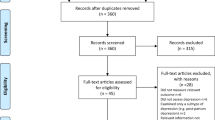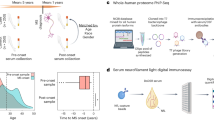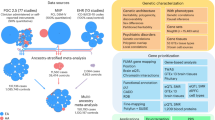Abstract
The etiopathology of bipolar disorder is largely unknown. We collected cerebrospinal fluid (CSF) samples from two independent case-control cohorts (total n = 351) to identify proteins associated with bipolar disorder. A panel of 92 proteins targeted towards central nervous system processes identified two proteins that replicated across the cohorts: the CSF concentrations of testican-1 were lower, and the CSF concentrations of C-type lectin domain family 1 member B (CLEC1B) were higher, in cases than controls. In a restricted subgroup analysis, we compared only bipolar type 1 with controls and identified two additional proteins that replicated in both cohorts: draxin and tumor necrosis factor receptor superfamily member 21 (TNFRSF21), both lower in cases than controls. This analysis additionally revealed several proteins significantly associated with bipolar type 1 in one cohort, falling just short of replicated statistical significance in the other (tenascin-R, disintegrin and metalloproteinase domain-containing protein 23, cell adhesion molecule 3, RGM domain family member B, plexin-B1, and brorin). Next, we conducted genome-wide association analyses of the case-control-associated proteins. In these analyses, we found associations with the voltage-gated calcium channel subunit CACNG4, and the lipid-droplet-associated gene PLIN5 with CSF concentrations of TNFRSF21 and CLEC1B, respectively. The reported proteins are involved in neuronal cell-cell and cell-matrix interactions, particularly in the developing brain, and in pathways of importance for lithium’s mechanism of action. In summary, we report four novel CSF protein associations with bipolar disorder that replicated in two independent case-control cohorts, shedding new light on the central nervous system processes implicated in bipolar disorder.
This is a preview of subscription content, access via your institution
Access options
Subscribe to this journal
Receive 12 print issues and online access
$259.00 per year
only $21.58 per issue
Buy this article
- Purchase on Springer Link
- Instant access to full article PDF
Prices may be subject to local taxes which are calculated during checkout


Similar content being viewed by others
References
Goodwin FK, Manic-depressive illness: bipolar disorders and recurrent depression. 2nd edn. Oxford University Press: New York, 2007.
Merikangas KR, Jin R, He JP, Kessler RC, Lee S, Sampson NA, et al. Prevalence and correlates of bipolar spectrum disorder in the world mental health survey initiative. Arch Gen Psychiatry. 2011;68:241–51.
Ferrari AJ, Stockings E, Khoo J-P, Erskine HE, Degenhardt L, Vos T, et al. The prevalence and burden of bipolar disorder: findings from the Global Burden of Disease Study 2013. Bipolar Disord. 2016;18:440–50.
Ekman M, Granström O, Omérov S, Jacob J, Landén M. The societal cost of bipolar disorder in Sweden. Soc Psychiatry Psychiatr Epidemiol. 2013;48:1601–10.
Edvardsen J, Torgersen S, Røysamb E, Lygren S, Skre I, Onstad S, et al. Heritability of bipolar spectrum disorders. Unity or heterogeneity? J Affect Disord. 2008;106:229–40.
McGuffin P, Rijsdijk F, Andrew M, Sham P, Katz R, Cardno A. The heritability of bipolar affective disorder and the genetic relationship to unipolar depression. Arch Gen Psychiatry. 2003;60:497–502.
Mullins N, Forstner AJ, O’Connell KS, Coombes B, Coleman JRI, Qiao Z, et al. Genome-wide association study of more than 40,000 bipolar disorder cases provides new insights into the underlying biology. Nat Genet. 2021;53:817–29.
Schutzer SE, Liu T, Natelson BH, Angel TE, Schepmoes AA, Purvine SO, et al. Establishing the proteome of normal human cerebrospinal fluid. PLoS One. 2010;5:e10980.
Kroksveen AC, Opsahl JA, Aye TT, Ulvik RJ, Berven FS. Proteomics of human cerebrospinal fluid: discovery and verification of biomarker candidates in neurodegenerative diseases using quantitative proteomics. J Proteom. 2011;74:371–88.
Knorr U, Simonsen AH, Zetterberg H, Blennow K, Hasselbalch SG, Kessing LV. Biomarkers in cerebrospinal fluid of patients with bipolar disorder versus healthy individuals: A systematic review. Eur Neuropsychopharmacol: J Eur Coll Neuropsychopharmacol. 2018;28:783–94.
Sjöström R, Roos BE. 5-Hydroxyindolacetic acid and homovanillic acid in cerebrospinal fluid in manic-depressive psychosis. Eur J Clin Pharm. 1972;4:170–176.
Pålsson E, Sellgren C, Ryden E, Kizza R, Pelanis A, Zetterberg H, et al. Cerebrospinal fluid monoamine metabolite profiles in bipolar disorder, ADHD, and controls. J Neural Transm (Vienna). 2017;124:1135–43.
Sellgren CM, Kegel ME, Bergen SE, Ekman CJ, Olsson S, Larsson M, et al. A genome-wide association study of kynurenic acid in cerebrospinal fluid: implications for psychosis and cognitive impairment in bipolar disorder. Mol Psychiatry. 2016;21:1342–50.
Koslow SH, Maas JW, Bowden CL, Davis JM, Hanin I. Javaid JCSF and urinary biogenic amines and metabolites in depression and mania: a controlled, univariate analysis. Arch Gen Psychiatry. 1983;40:999–1010.
Al Shweiki MR, Oeckl P, Steinacker P, Barschke P, Dorner-Ciossek C, Hengerer B, et al. Proteomic analysis reveals a biosignature of decreased synaptic protein in cerebrospinal fluid of major depressive disorder. Transl psychiatry. 2020;10:1–12.
Rydén E, Thase ME, Stråht D, Aberg-Wistedt A, Bejerot S, Landén M. A history of childhood attention-deficit hyperactivity disorder (ADHD) impacts clinical outcome in adult bipolar patients regardless of current ADHD. Acta Psychiatr Scand. 2009;120:239–46.
Jakobsson J, Zetterberg H, Blennow K, Johan Ekman C, Johansson AGM, Landén M. Altered concentrations of amyloid precursor protein metabolites in the cerebrospinal fluid of patients with bipolar disorder. Neuropsychopharmacol: Off Publ Am Coll Neuropsychopharmacol. 2013;38:664–72.
Ekman CJ, Lind J, Rydén E, Ingvar M, Landén M. Manic episodes are associated with grey matter volume reduction - a voxel-based morphometry brain analysis. Acta Psychiatr Scand. 2010;122:507–15.
Sachs GS, Thase ME, Otto MW, Bauer M, Miklowitz D, Wisniewski SR, et al. Rationale, design, and methods of the systematic treatment enhancement program for bipolar disorder (STEP-BD). Biol Psychiatry. 2003;53:1028–42.
Assarsson E, Lundberg M, Holmquist G, Björkesten J, Thorsen SB, Ekman D et al. Homogenous 96-plex PEA immunoassay exhibiting high sensitivity, specificity, and excellent scalability. PLoS One 2014; 9.
Andersson M, Alvarez-Cermeno J, Bernardi G, Cogato I, Fredman P, Frederiksen J, et al. Cerebrospinal fluid in the diagnosis of multiple sclerosis: a consensus report. J Neurol Neurosurg Psychiatry. 1994;57:897–902.
Song J, Bergen SE, Di Florio A, Karlsson R, Charney A, Ruderfer DM, et al. Genome-wide association study identifies SESTD1 as a novel risk gene for lithium-responsive bipolar disorder. Mol Psychiatry. 2016;21:1290–1297.
Lam M, Awasthi S, Watson HJ, Goldstein J, Panagiotaropoulou G, Trubetskoy V, et al. RICOPILI: Rapid Imputation for COnsortias PIpeLIne. Bioinformatics. 2020;36:930–933.
McCarthy S, Das S, Kretzschmar W, Delaneau O, Wood AR, Teumer A, et al. A reference panel of 64,976 haplotypes for genotype imputation. Nat Genet. 2016;48:1279–83.
Benjamini Y, Hochberg Y. Controlling the false discovery rate: a practical and powerful approach to multiple testing. J R Stat Soc Ser B (Methodol). 1995;57:289–300.
Chang CC, Chow CC, Tellier LCAM, Vattikuti S, Purcell SM, Lee JJ. Second-generation PLINK: rising to the challenge of larger and richer datasets. GigaScience 2015; 4.
Purcell S, Chang C PLINK 2.0. www.cog-genomics.org/plink/2.0/
Willer CJ, Li Y, Abecasis GR. METAL: fast and efficient meta-analysis of genomewide association scans. Bioinformatics. 2010;26:2190–2191.
de Leeuw CA, Mooij JM, Heskes T, Posthuma D. MAGMA: generalized gene-set analysis of GWAS data. PLoS Comput Biol. 2015;11:e1004219.
Bonnet F, Périn J-P, Charbonnier F, Camuzat A, Roussel G, Nussbaum J-L, et al. Structure and cellular distribution of mouse brain testican. J Biol Chem. 1996;271:4373–80.
The UniProt Consortium. UniProt: the universal protein knowledgebase in 2021. Nucleic Acids Res 2021; 49: D480-D489.
Yang J, Yang Q, Yu J, Li X, Yu S, Zhang X. SPOCK1 promotes the proliferation, migration and invasion of glioma cells through PI3K/AKT and Wnt/β-catenin signaling pathways. Oncol Rep. 2016;35:3566–76.
Wang T, Liu X, Tian Q, Liang T, Chang P. Reduced SPOCK1 expression inhibits non-small cell lung cancer cell proliferation and migration through Wnt/β-catenin signaling. Eur Rev Med Pharm Sci. 2018;22:637–44.
Jope RS. Lithium and GSK-3: one inhibitor, two inhibitory actions, multiple outcomes. Trends Pharm Sci. 2003;24:441–443.
Jabbari E, Woodside J, Guo T, Magdalinou NK, Chelban V, Athauda D, et al. Proximity extension assay testing reveals novel diagnostic biomarkers of atypical parkinsonian syndromes. J Neurol Neurosurg Psychiatry. 2019;90:768–73.
Barrera-Ocampo A, Arlt S, Matschke J, Hartmann U, Puig B, Ferrer I, et al. Amyloid-beta Precursor Protein Modulates the Sorting of Testican-1 and Contributes to Its Accumulation in Brain Tissue and Cerebrospinal Fluid from Patients with Alzheimer Disease. J Neuropathol Exp Neurol. 2016;75:903–16.
Iseki K, Hagino S, Zhang Y, Mori T, Sato N, Yokoya S, et al. Altered expression pattern of testican-1 mRNA after brain injury. Biomed Res. 2011;32:373–378.
Herzog BH, Fu J, Wilson SJ, Hess PR, Sen A, McDaniel JM, et al. Podoplanin maintains high endothelial venule integrity by interacting with platelet CLEC-2. Nature. 2013;502:105–109.
Uhlen M, Fagerberg L, Hallstrom BM, Lindskog C, Oksvold P, Mardinoglu A et al. Proteomics. Tissue-based map of the human proteome. Science 2015; 347: 1260419. http://www.proteinatlas.org
Zetterberg H, Jakobsson J, Redsäter M, Andreasson U, Pålsson E, Ekman CJ, et al. Blood-cerebrospinal fluid barrier dysfunction in patients with bipolar disorder in relation to antipsychotic treatment. Psychiatry Res. 2014;217:143–146.
Islam SM, Shinmyo Y, Okafuji T, Su Y, Naser IB, Ahmed G, et al. Draxin, a Repulsive Guidance Protein for Spinal Cord and Forebrain Commissures. Science. 2009;323:388–93.
Shinmyo Y, Asrafuzzaman Riyadh M, Ahmed G, Bin Naser I, Hossain M, Takebayashi H et al. Draxin from neocortical neurons controls the guidance of thalamocortical projections into the neocortex. 2015; 6: 10232.
Bryois J, Skene NG, Hansen TF, Kogelman LJA, Watson HJ, Liu Z, et al. Genetic identification of cell types underlying brain complex traits yields insights into the etiology of Parkinson’s disease. Nat Genet. 2020;52:482–93.
Meli R, Weisová P, Propst F. Repulsive axon guidance by Draxin is mediated by protein Kinase B (Akt), glycogen synthase kinase-3β (GSK-3β) and microtubule-associated protein 1B. PLoS One. 2015;10:e0119524.
Tawarayama H, Yamada H, Amin R, Morita-Fujimura Y, Cooper HM, Shinmyo Y et al. Draxin regulates hippocampal neurogenesis in the postnatal dentate gyrus by inhibiting DCC-induced apoptosis. Sci Rep 2018; 8.
Mi S, Lee X, Hu Y, Ji B, Shao Z, Yang W, et al. Death receptor 6 negatively regulates oligodendrocyte survival, maturation and myelination. Nat Med. 2011;17:816–21.
Nikolaev A, McLaughlin T, O’Leary DD, Tessier-Lavigne M. APP binds DR6 to trigger axon pruning and neuron death via distinct caspases. Nature. 2009;457:981–989.
Yang L, Katchman A, Morrow JP, Doshi D, Marx SO. Cardiac L-type calcium channel (Cav1.2) associates with gamma subunits. FASEB J. 2011;25:928–36.
Ferreira MA, O’Donovan MC, Meng YA, Jones IR, Ruderfer DM, Jones L, et al. Collaborative genome-wide association analysis supports a role for ANK3 and CACNA1C in bipolar disorder. Nat Genet. 2008;40:1056–1058.
Stegmann S, Werner JM, Kuhl S, Röhn G, Krischek B, Stavrinou P, et al. Death Receptor 6 (DR6) Is Overexpressed in Astrocytomas. Anticancer Res. 2019;39:2299–306.
Timirci-Kahraman O, Karaaslan Z, Tuzun E, Kurtuncu M, Baykal AT, Gunduz T, et al. Identification of candidate biomarkers in converting and non-converting clinically isolated syndrome by proteomics analysis of cerebrospinal fluid. Acta Neurol Belg. 2019;119:101–11.
Enroth S, Hallmans G, Grankvist K, Gyllensten U. Effects of long-term storage time and original sampling month on biobank plasma protein concentrations. EBioMedicine. 2016;12:309–14.
Gandal MJ, Haney JR, Parikshak NN, Leppa V, Ramaswami G, Hartl C, et al. Shared molecular neuropathology across major psychiatric disorders parallels polygenic overlap. Science. 2018;359:693–697.
Smirnova L, Seregin A, Boksha I, Dmitrieva E, Simutkin G, Kornetova E, et al. The difference in serum proteomes in schizophrenia and bipolar disorder. BMC Genomics. 2019;20:535–535.
Cross-Disorder Group of the Psychiatric Genomics Consortium. Identification of risk loci with shared effects on five major psychiatric disorders: a genome-wide analysis. Lancet (Lond, Engl). 2013;381:1371–1379.
Acknowledgements
This study was a part of the St. Göran bipolar project. We are deeply grateful to the patients and controls participating in this study. We also thank staff at the bipolar outpatient clinics in Stockholm (Norra Stockholms Psykiatri) and Gothenburg (Bipolärmottagningen), including study nurses Martina Wennberg, Lena Lundberg, Agneta Carlswärd-Kjellin, Annika Blom, Benita Gezelius, Therese Thuresson, and Stefanie Unger, as well as data managers Haydeh Olofsson and Mathias Kardell. Yngve Hallström and Aurimantas Pelanis performed the lumbar punctures. The St. Göran bipolar study was funded by grants from the Swedish foundation for Strategic Research (#KF10-0039), the Swedish Medical Research Council (#2018-02653), the Swedish Brain foundation (#FO2020-0261), and by the Swedish state under the agreement between the Swedish government and the county councils, the ALF-agreement (#ALF 20170019, #ALFGBG-716801). Further support was provided by the Swedish Research Council for Health, Working Life and Welfare, Åhlen’s foundation, Magnus Bergvall’s foundation, the Lars Hierta Memorial Foundation, and Märta Lundqvist’s foundation. HZ is a Wallenberg Scholar supported by grants from the Swedish Research Council (#2018-02532), the European Research Council (#681712), Swedish State Support for Clinical Research (#ALFGBG-720931), the Alzheimer Drug Discovery Foundation (ADDF), USA (#201809-2016862), the AD Strategic Fund and the Alzheimer’s Association (#ADSF-21-831376-C, #ADSF-21-831381-C and #ADSF-21-831377-C), the Olav Thon Foundation, the Erling-Persson Family Foundation, Stiftelsen för Gamla Tjänarinnor, the Swedish Brain foundation (#FO2019-0228), the European Union’s Horizon 2020 research and innovation program under the Marie Skłodowska-Curie grant agreement No 860197 (MIRIADE), and the UK Dementia Research Institute at UCL.
Author information
Authors and Affiliations
Contributions
ML, JHL, JJ, and EP concepted the study. ML, AP, and TS collected the samples. AG and AI analyzed the data. LJ, EP, and HZ contributed to the interpretation. AG and ML wrote the manuscript. All authors revised and approved the manuscript.
Corresponding author
Ethics declarations
Competing interests
ML declares that he has received lecture honoraria from Lundbeck pharmaceutical. JJ declares that he was an employee at AstraZeneca pharmaceutical 2017-2019, and JHL declares that she is a current employee at AstraZeneca pharmaceutical. HZ has served at scientific advisory boards for Alector, Eisai, Denali, Roche Diagnostics, Wave, Samumed, Siemens Healthineers, Pinteon Therapeutics, Nervgen, AZTherapies, and CogRx, has given lectures in symposia sponsored by Cellectricon, Fujirebio, Alzecure, and Biogen, and is a co-founder of Brain Biomarker Solutions in Gothenburg AB (BBS), which is a part of the GU Ventures Incubator Program. Other authors declare no conflict of interest.
Additional information
Publisher’s note Springer Nature remains neutral with regard to jurisdictional claims in published maps and institutional affiliations.
Supplementary information
Rights and permissions
About this article
Cite this article
Göteson, A., Isgren, A., Jonsson, L. et al. Cerebrospinal fluid proteomics targeted for central nervous system processes in bipolar disorder. Mol Psychiatry 26, 7446–7453 (2021). https://doi.org/10.1038/s41380-021-01236-5
Received:
Revised:
Accepted:
Published:
Issue Date:
DOI: https://doi.org/10.1038/s41380-021-01236-5
This article is cited by
-
Cerebrospinal fluid proteomic study of two bipolar disorder cohorts
Molecular Psychiatry (2022)
-
A serum proteomic study of two case-control cohorts identifies novel biomarkers for bipolar disorder
Translational Psychiatry (2022)



